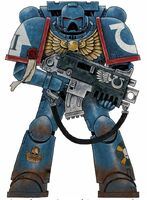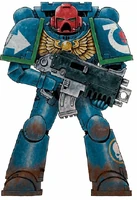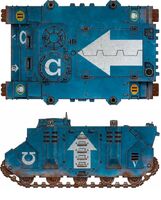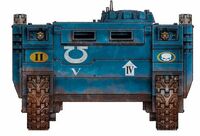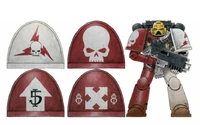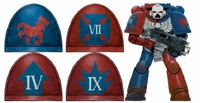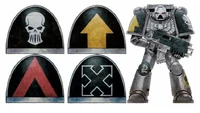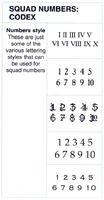No edit summary Tag: sourceedit |
No edit summary Tag: rte-wysiwyg |
||
| Line 5: | Line 5: | ||
With the threat of the [[Traitor Legions]] held at bay in the wake of the [[Great Scouring]], Roboute Guilliman turned to ensuring that such a catastrophic inter-species war could never happen again, distilling his formidable wisdom into the mighty tome known as the ''Codex Astartes''. This text became a major part of his legacy and the cornerstone upon which the future of the [[Adeptus Astartes]] would be based. No complete copies of his original text is known to exist although the majority of his tome has survived and is available to all space marines, if not committed to memory . |
With the threat of the [[Traitor Legions]] held at bay in the wake of the [[Great Scouring]], Roboute Guilliman turned to ensuring that such a catastrophic inter-species war could never happen again, distilling his formidable wisdom into the mighty tome known as the ''Codex Astartes''. This text became a major part of his legacy and the cornerstone upon which the future of the [[Adeptus Astartes]] would be based. No complete copies of his original text is known to exist although the majority of his tome has survived and is available to all space marines, if not committed to memory . |
||
| − | Though for all its multitudinous topics, the most lasting and contentious decree of the ''Codex Astartes'' was that the existing Space Marine Legions be broken up and reorganised into smaller organisations known as [[Chapters]]. Though many of his brother Primarchs initially railed against Guilliman's decree, almost all eventually accepted the necessity of reorganisation for the security of the Imperium. |
+ | Though for all its multitudinous topics, the most lasting and contentious decree of the ''Codex Astartes'' was that the existing Space Marine Legions be broken up and reorganised into smaller organisations known as [[Chapters]]. Though many of his brother Primarchs initially railed against Guilliman's decree, almost all eventually accepted the necessity of reorganisation for the security of the Imperium. |
Upon the ''Codex's'' implementation, in an event that would become known as the [[Second Founding]], each of the old Legions became a conclave of chapters, one of which would bear the name for its forebear legion as well as heraldry, homeworld, and would retain some level of political primacy amongst its peers. The rest would take new names, heraldry, and homeworlds or fortress-monasteries, and stretch themselves across the Imperium. The ''Codex Astartes'' stated that each Chapter would be one thousand Battle-Brothers strong and look to its own recruitment, training and equipment. Never again would one man be able to command the awesome, terrifying power of a Space Marine Legion. |
Upon the ''Codex's'' implementation, in an event that would become known as the [[Second Founding]], each of the old Legions became a conclave of chapters, one of which would bear the name for its forebear legion as well as heraldry, homeworld, and would retain some level of political primacy amongst its peers. The rest would take new names, heraldry, and homeworlds or fortress-monasteries, and stretch themselves across the Imperium. The ''Codex Astartes'' stated that each Chapter would be one thousand Battle-Brothers strong and look to its own recruitment, training and equipment. Never again would one man be able to command the awesome, terrifying power of a Space Marine Legion. |
||
| Line 93: | Line 93: | ||
*'''[[Apothecaries]]''' - Wear white armor traditionally, irrespective of what Chapter they belong to, but some, Ultramarines Apothecaries to note, chose to sport their chapter colors predominantly while still being heavily adorned with white. They wear their Chapter Badge as normal. |
*'''[[Apothecaries]]''' - Wear white armor traditionally, irrespective of what Chapter they belong to, but some, Ultramarines Apothecaries to note, chose to sport their chapter colors predominantly while still being heavily adorned with white. They wear their Chapter Badge as normal. |
||
*'''[[Sergeant (Space Marine)|Sergeants]]''' - Wear the same heraldry as their squad, but carry the squad's banner, which displays the Chapter Badge and the squad's number, plus a red skull (the symbol of a Sergeant). Sergeants often paint their helmets red, or in some cases wear a red skull on their helmet instead. |
*'''[[Sergeant (Space Marine)|Sergeants]]''' - Wear the same heraldry as their squad, but carry the squad's banner, which displays the Chapter Badge and the squad's number, plus a red skull (the symbol of a Sergeant). Sergeants often paint their helmets red, or in some cases wear a red skull on their helmet instead. |
||
| − | *'''[[Veteran Marine|Veteran Sergeants]]''' - Wear the same heraldry as their squad, but carry the squad's banner, which displays the Chapter Badge and the squad's number, plus a red skull (the symbol of a Sergeant). Veteran Sergeants often paint their helmets red like standard Space Marine Sergeants and add an additional white stripe or laurel wreath that indicates their Veteran status. |
+ | *'''[[Veteran Marine|Veteran Sergeants]]''' - Wear the same heraldry as their squad, but carry the squad's banner, which displays the Chapter Badge and the squad's number, plus a red skull (the symbol of a Sergeant). Veteran Sergeants often paint their helmets red like standard Space Marine Sergeants and add an additional white stripe or laurel wreath that indicates their Veteran status. |
*'''[[Terminators]]''' - Veteran Battle-Brothers, usually of the 1<sup>st</sup> Company, who make use of Tactical Dreadnought Armour. |
*'''[[Terminators]]''' - Veteran Battle-Brothers, usually of the 1<sup>st</sup> Company, who make use of Tactical Dreadnought Armour. |
||
| Line 123: | Line 123: | ||
===Space Wolves=== |
===Space Wolves=== |
||
[[File:Space Wolves Badge1.png|thumb|150px|[[Chapter]] Badge of the [[Space Wolves]]]] |
[[File:Space Wolves Badge1.png|thumb|150px|[[Chapter]] Badge of the [[Space Wolves]]]] |
||
| − | The [[Space Wolves]] strongly resist the central command structure of the Imperium. The sons of Russ never fully bowed to the Codex and certainly do not now. Theirs is a philosophical deviance. Given that they live for the honour of battle, it is almost certain that the younger Space Wolves will abandon a standard tactical structure in favour of simply rushing headlong at the enemy, howling at the tops of their voices. |
+ | The [[Space Wolves]] strongly resist the central command structure of the Imperium. The sons of Russ never fully bowed to the Codex and certainly do not now. Theirs is a philosophical deviance. Given that they live for the honour of battle, it is almost certain that the younger Space Wolves will abandon a standard tactical structure in favour of simply rushing headlong at the enemy, howling at the tops of their voices. |
====See Also==== |
====See Also==== |
||
*[http://warhammer40k.wikia.com/wiki/Space_Wolves#Post-Heresy_2 '''Space Wolves Specialist Ranks'''] |
*[http://warhammer40k.wikia.com/wiki/Space_Wolves#Post-Heresy_2 '''Space Wolves Specialist Ranks'''] |
||
| Line 184: | Line 184: | ||
</gallery> |
</gallery> |
||
[[Category:C]] |
[[Category:C]] |
||
| − | [[Category:History]] |
||
[[Category:Imperial History]] |
[[Category:Imperial History]] |
||
[[Category:Imperium]] |
[[Category:Imperium]] |
||
Revision as of 05:11, 26 August 2016
"We follow in the footsteps of Guilliman. As it is written in the Codex, so shall it be."
- — Marneus Calgar, Chapter Master of the Ultramarines

A page taken from the Codex Astartes displaying the organisation and structure of a Space Marine Chapter
The Codex Astartes is a great and sacred tome of military organisation, strategy and tactics written by Roboute Guilliman, the Primarch of the Ultramarines Space Marine Legion, to prevent another civil war like the Horus Heresy. It outlines Guilliman's ideal for the moral behaviour, order of battle and tactical doctrine of a Space Marine Chapter. While not all Space Marine Chapters in the Imperium adhere to the Codex's dictates with the same rigidity as the Ultramarines, most obey the spirit of the Codex if not the actual letter. A Space Marine Chapter that generally follows the guidelines of the Codex Astartes is referred to as a "Codex-compliant Chapter."
With the threat of the Traitor Legions held at bay in the wake of the Great Scouring, Roboute Guilliman turned to ensuring that such a catastrophic inter-species war could never happen again, distilling his formidable wisdom into the mighty tome known as the Codex Astartes. This text became a major part of his legacy and the cornerstone upon which the future of the Adeptus Astartes would be based. No complete copies of his original text is known to exist although the majority of his tome has survived and is available to all space marines, if not committed to memory .
Though for all its multitudinous topics, the most lasting and contentious decree of the Codex Astartes was that the existing Space Marine Legions be broken up and reorganised into smaller organisations known as Chapters. Though many of his brother Primarchs initially railed against Guilliman's decree, almost all eventually accepted the necessity of reorganisation for the security of the Imperium.
Upon the Codex's implementation, in an event that would become known as the Second Founding, each of the old Legions became a conclave of chapters, one of which would bear the name for its forebear legion as well as heraldry, homeworld, and would retain some level of political primacy amongst its peers. The rest would take new names, heraldry, and homeworlds or fortress-monasteries, and stretch themselves across the Imperium. The Codex Astartes stated that each Chapter would be one thousand Battle-Brothers strong and look to its own recruitment, training and equipment. Never again would one man be able to command the awesome, terrifying power of a Space Marine Legion.
Over the millennia, there have been many subsequent Foundings of Space Marine Chapters. Those Chapters that adhere rigidly to Guilliman's teachings are sometimes referred to as "Codex Chapters." These Space Marines pride themselves on following the tenets within the hallowed pages of the Codex Astartes and applying its principles of warcraft and devotion to the Emperor.
History
"They shall be pure of heart and strong of body, untainted by doubt and unsullied by self-aggrandisement. They will be bright stars on the firmament of battle, Angels of Death whose shining wings bring swift annihilation to the enemies of Man. So it shall be for a thousand times for a thousand years, unto the very end of eternity and the extinction of mortal flesh."
- — Opening passage of the Codex Astartes
In the wake of the calamity that was the Horus Heresy, the foundations of the Imperium of Man were laid down. The first High Lords of Terra established the structure by which the Adeptus Terra operated, and described the feudal responsibilities and duties of the planetary lords. One of the most important accomplishments was the reorganisation of the Imperium's fighting forces. This was undertaken almost single-handedly by the Primarch of the Ultramarines Legion, Roboute Guilliman, who with characteristic speed and efficiency codified the structure of the Imperial Guard, the Imperial Navy, and the Space Marines. Of all of his works, the most influential is the Codex Astartes, the great prescriptive tome that lays down the basic organisational and tactical rules for the Space Marine Chapters.
The initial inspiration for Guilliman's Codex Astartes came from Sergeant Aeonid Thiel, a veteran of the Underworld War, who was present on Calth during the war against the treacherous Word Bearers. In the aftermath of the initial assault, he founded small independent task-force squads called the Red Marked, which were made up of surviving Ultramarines. The Red Marked were responsible for rooting out and eliminating the forces of the renegade warbands that were hiding on the ruined worlds of the Ultramar space.
During the important meeting between the Ultramarine's Primarch and Sergeant Aeonid Thiel on one of Macragge's space stations, Guilliman tore apart the documents of his old doctrines in front of Thiel and made his message clear; from now on, the Ultramarines shall not be a "horde under a warlord that follows him" but a "hundred of thousands of individual Legionaries each in support of the other". Thus was the vision for the Codex Astartes born.
Following the end of the Horus Heresy and the retreat of most of the Traitor Legions into the Eye of Terror, the Codex decreed that the nine remaining Loyalist Legions would be divided into 1,000-man Chapters, the Chapter Masters of which would be directly beholden to the Emperor Himself and no other, not even the Primarchs of their original founding Legions (save in the case of the single Chapter that would remain under each Primarch's control and retain its Legion's original name). No one man in the Imperium could ever again control the superhuman might of an entire Legion of 100,000 or more Space Marines.
The Horus Heresy had revealed previously unknown genetic weakness in the gene-seed of the Primarchs and Space Marines among the original 20 First Founding Space Marine Legions, weaknesses that left the Legions in question greatly exposed to corruption by the Ruinous Powers of Chaos. This risk was exacerbated by the rapid nature of Space Marine recruitment during the centuries between the start of the Great Crusade in ca. 800.M30 and the outbreak of the Horus Heresy itself in the early 31st Millennium. With the Imperium of Man expanding so quickly across the galaxy during the Great Crusade, the need for fresh recruits in the Space Marine Legions was great. So much so that some Legions had not been as particular in their gene-seed screening practices and recruit selection processes as they should have been. The first objective of Roboute Guilliman in writing the Codex Astartes was to both recognise and purge these weaknesses. As a result, the Codex Astartes decreed that Space Marines would forever more be created and trained slowly. The genetic banks used to create Astartes implants would be carefully monitored and scrutinised for any defects. Cultivated organs would be subject to the most stringent tests of purity. Young Initiates would undergo trials of suitability before they were accepted, and only those of the very sternest character would be chosen.
As a final safeguard, Guilliman tasked the Adeptus Terra on Earth with setting up and maintaining genetic banks to produce and store tithes of Space Marine gene-seed. These banks were to provide all new gene-seed for subsequent Foundings of Space Marine Chapters. To prevent cross-contamination, the genetic stock of each Legion was isolated whilst that of the Traitor Legions was placed under a time-locked stasis seal, though at the time many believed they had been destroyed. By taking direct control of these genetic tithes, the Adeptus Terra could ultimately control the Space Marines. They alone had and have the power to destroy or create Space Marine armies at will.
The Codex outlined a new, more measured process for Space Marine selection and recruitment and insisted that each newly-created Successor Chapter would tithe 5% of its genetic material to the Adeptus Terra and the Adeptus Mechanicus for testing and monitoring. It also decreed that only the Emperor Himself, through the auspices of the High Lords of Terra, would ever again be able to order the creation of a new Space Marine Chapter. All gene-seed would be subjected to the greatest genetic scrutiny before being used in the creation of new Space Marine implants. To prevent cross-contamination, the Codex rebuked the practice of sharing gene-seed between different Chapters and, thus preventing different Legions with different genetic make-ups. From then on, each Chapter would have to rely solely on the gene-seed produced in the bodies of its own Space Marines.
The Codex also further defined the accepted tactical doctrine, Chapter organisation, order of battle, and recruitment practices for a Space Marine Chapter. It explained the different battlefield roles assigned to each squad of Space Marines in a Chapter, defining them as Tactical, Assault or Devastator Squads and assigning different equipment and purpose to each (see the excerpts below).
There were many other topics covered in the Codex and all of them displayed Guilliman's formidable intelligence and hard-won wisdom. Most of the old Legions were divided into fewer than five Chapters, but the Ultramarines, being by far the largest of the Legions, were divided many times. The exact number of new Chapters created from the Ultramarines is uncertain: the number listed in the oldest known copy of the Codex Astartes (the so-called Apocrypha of Skaros) gives the total as 24, but does not name them all. These Chapters would consist of ten companies of 100 Space Marines each. The breaking of the remaining nine Loyalist Legions into multiple Space Marine Chapters is known to Imperial historians as the Second Founding, which occurred in ca. 021.M31, seven standard years after the death of Horus.
As a result of the Second Founding, the Ultramarines' gene-seed became the favoured genetic stock of most subsequent Foundings. The new Chapters created from the Ultramarines are often referred to as the Primogenitors, or "first born." All of the Primogenitor Chapters venerate Roboute Guilliman as their founding father and patron. Only one of the original Space Marine Legions, the Space Wolves, has never been broken down into the ten companies decreed in the Codex Astartes. The Space Wolves continue to organize their forces into thirteen "Great Companies," different in organization to those specified by the Codex. Note that the oldest copy of the Codex, the Apocrypha of Skaros, refutes the commonly-held belief that the Space Wolves have never broken down into separate Chapters, stating that two Second Founding Chapters were created from the Space Wolves (Index Astartes I, pg. 13). However, the Space Marine Codex (5th Edition) lists only one Second Founding Successor to the Space Wolves: the Wolf Brothers, who were disbanded at an unknown time because of extreme gene-seed corruption and mutation.
The Codex Astartes further defines the tactical roles, equipment specifications, and uniform identification markings of the Space Marines. With the passage of centuries, some Chapters have strayed from the strict letter of the Codex, introducing unique variations on its teachings but remaining broadly faithful to Guilliman's basic principles. Furthermore, the Codex has been reanalyzed, reinterpreted and modified countless times over the centuries. Regardless, the Codex Astartes remains, as it has always been, the Space Marines' authoritative guide to waging war. As such, it is revered by every Battle-Brother as a holy text; the wisdom of the ancients serving as both scripture and the unbending rod by which they are measured.These guidelines have evolved in practice from chapter to chapter over the centuries, and the treatise and wisdom of hundreds of military thinkers have been absorbed in their own battle philosophies. The Codex Astartes is revered as a holy text, and many Chapters regard its recommendations as sanctified by the Emperor Himself.
Chapter Organisation
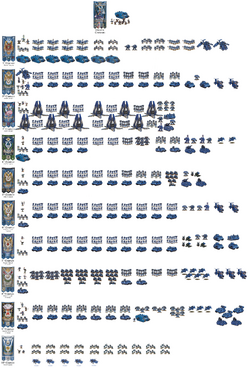
The order of battle of the Ultramarines, the archetypal Codex Astartes-compliant Space Marine Chapter, displaying the full composition of all ten companies
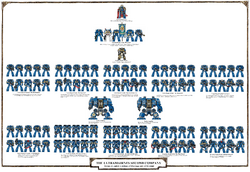
Order of Battle of the Ultramarines 2nd Company, "Guardians of the Temple"; an excellent example of a post-Heresy Codex Astartes-compliant Space Marine company
The Codex Astartes states that a Space Marine Chapter should be split into 10 Companies of 100 Space Marines each, plus a Space Marine Captain, Apothecary, Company Standard and Chaplain for each company. Existing outside the Company level organization, each Chapter has an Armoury consisting of the Chapter's Techmarines, main battle tanks, and other armoured vehicles, a Librarium consisting of the Chapter's Librarians, a Chapter Fleet and the Chapter Master, plus various headquarters staff and the Chapter's Servitors and human Chapter Serfs.
Veteran Company
The 1st Company of a Chapter consists of Veteran Squads and/or Terminator Squads. Support for the 1st Company consists of Land Raiders and Venerable Dreadnoughts. Only the 1st Company may use the hallowed suits of Terminator (Tactical Dreadnought) Armour.
Battle Companies
The 2nd, 3rd, 4th and 5th Companies of a Chapter are known as Battle Companies and they all have the same tactical organisation. Each Battle Company is split into 6 Tactical Squads, 2 Assault Squads and 2 Devastator Squads comprised of 10 Space Marines each. Some companies also make use of Command Squads comprised solely of Veterans to protect their officers or other specialists like Apothecaries and Chaplains. The Assault Squads can instead be deployed as Bike Squadrons or on Land Speeders. Battle Companies often use Rhino and Razorback dedicated transports, and commonly deploy Dreadnoughts for heavy fire support.
Reserve Companies
The 6th, 7th, 8th and 9th Companies of a Chapter are its Reserve Companies. The 6th and 7th are comprised entirely of Tactical Squads, the 8th of Assault Squads and the 9th of Devastator Squads. Like the Battle Companies, the Reserve Companies also make extensive use of Rhino and Razorback transports, though Dreadnoughts are usually only found in the 9th Company. The 6th Company can be entirely deployed on Space Marine Assault Bikes and the 7th on Land Speeders. The 8th Company can use either Space Marine Bikes or Land Speeders. These forces are held in reserve to be deployed at the discretion of Force Commanders as tactical situations evolve, often to bolster weak points or aid in breaking through enemy lines at specific locations.
Scout Company
The 10th Company consists entirely ofScout Squads and is often not 100 strong as recruitment does not provide a steady flow of Neophytes to many Chapters. As such, the 10th Company is the most lightly armed and is most often used as a reconnaissance or guerilla force. Scout Marines are sometimes mounted on Space Marine Bikes, but do not use Rhino or Razorback transports.
Heraldry
The Codex Astartes contains detailed sections pertaining to the heraldry of Space Marine Chapters. These dictate that a Space Marine should display his Chapter's symbol upon his armour's left shoulder guard, whilst his right shoulder guard should show his squad markings. The Codex also states that a Space Marine should incorporate his company's heraldic colour into his armour, displaying it on the trim of his shoulder guards. The Codex suggests a number of variations on this basic system and even advises that each Chapter periodically revise its markings to confound the foe. This has led to myriad differences between the many Codex Chapters and to some having varied their appearance over the millennia.
Each Chapter has its own unique Power Armour colour scheme and Chapter Badge; however, Codex-compliant Chapters all follow a common heraldry system, though there are many slight variations from the system described below.
Company Colours
Each Company has a unique colour that its members wear, commonly on their power armour's shoulder plate rims, but some Chapters use chest eagles, bolter cases, knee pads, helmets or other parts of a Space Marine's Power Armour.
- 1st Company - White or Silver - Members of the 1st Company should also paint their helmet the company colour.
- 2nd Company - Yellow or Gold
- 3rd Company - Red
- 4th Company - Green
- 5th Company - Black
- 6th Company - Orange
- 7th Company - Purple
- 8th Company - Grey
- 9th Company - Blue
- 10th Company - Nominally white, however the company colour is not displayed on the members' armour because they are Scouts.
Squad Markings
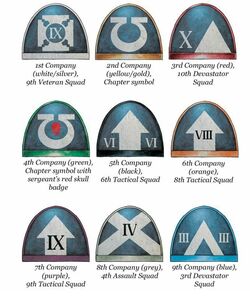
Examples of the Ultramarines' Codex-approved company colours and squad markings

The left shoulder plate of a Space Marine in Power Armour always shows the Space Marine's Chapter Badge. Squad markings are shown upon a Battle-Brother's right shoulder guard, except in the case of some older marks of Space Marine Power Armour that instead display them upon knee plates or within the Chapter badge itself. The right plate shows the Squad Badge, which indicates the tactical specialty of the squad the Astartes belongs to and the number of his squad within his company. Veteran Squads use a Maltese Cross, Tactical Squads use an arrow, Assault Squads use four perpendicular arrows pointing outwards and Devastator Squads use an inverted V. Space Marines in Terminator Armour wear the Crux Terminatus on their left shoulder plate, and their Chapter Badge on their right shoulder plate. A Sergeant's badge of rank is the red skull and is often displayed on the left shoulder. The Codex leaves the display of back banners to the Sergeant's discretion. Space Marine helmets frequently display rank and battle honours, either through colour or insignia. Red helmets, for example, are reserved for Sergeants, whilst a white helmet or laurel design denotes Veteran status. Veteran Sergeants typically wear both colours, incorporating a white stripe down the centre of their helm. Whilst company colours are typically displayed on the trim of a Space Marine’s shoulder guards, they can also be displayed on helmets, chest Aquilas, knee plates or even on the squad markings.
Vehicle Markings

Space Marine vehicle tactical specialty markings

Space Marine vehicle company designation roundels; note the colour of the roundel corresponds to the company's Codex-approved colour

Space Marine vehicle identification markings
The Codex Astartes has many pages devoted to regulations for the markings and heraldry of a Chapter's war machines and armoured vehicles. However, just as with Space Marine armour markings, the Codex also warns about complacency and the danger that enemy intelligence can pose. Because of this, the Codex encourages Chapter Masters to occasionally review their markings and offers many variants and alternative icons that can be displayed upon Space Marine main battle tanks.
Space Marine vehicles are generally painted in the livery of their Chapter. In addition to displaying the Chapter's icon, the vehicle's hull is also emblazoned with unit, squad and company markings, although the exact placement and application of these varies according to the Chapter and the vehicle in question. In addition, the most ancient vehicles may display mottos as well as honour badges and names; for their roll of battle victories is as illustrious as that of any breathing hero of the Chapter. Indeed, though every Dreadnought is assigned an identification number, this is quite often superfluous; every one is a famous hero of his Chapter whose names and histories are known even to raw recruits.
Troop transports, Centurion warsuits and armoured vehicles such as Assault Bikes, Attack Bikes and Land Speeders carry the same heraldry and organisational squad markings as the Space Marines that crew, or ride inside them. Space Marine tank crew typically display their vehicle's Chapter numerical designation within a roundel upon their right shoulder guard. Whilst every company maintains a permanent number of Rhino armoured transports, other vehicles are attached based upon an individual mission's requirements.When a vehicle is attached to a company, a small roundel shows the company’s number and/or corresponding colour. Chapter symbols are displayed prominently on the hulls and turrets of Space Marine vehicles. Space Marine battle tanks and Dreadnoughts are assigned a unique identification number within the company. This is typically rendered as a numeral upon the vehicle’s hull.
Army Campaign Badges

Space Marine Campaign Badges
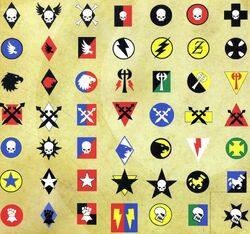
Various Army Campaign Badges worn by the forces of the Adeptus Astartes
When fighting alongside other forces of the Imperium of Man, it is common for the Imperial Commander to choose a simple symbol to act as the campaign badge. This army badge is used for the duration of the campaign and identifies every squad and vehicle in the task force. Normally painted upon the hull of Space Marine vehicles and the greave of a Battle-Brother's armour, it is not uncommon for these badges to be incorporated into an individual's heraldry as a permanent honour somewhere on his Power Armour after the campaign's completion, either to commemorate exceptional deeds or as a mark of remembrance for the fallen.
Officers and Specialists
- Captains - Wear the heraldry of their company, sometimes embellished with their own personal heraldry.
- Librarians- Wear blue armor, irrespective of what Chapter they belong to, and wear their Chapter Badge as normal. This practice is now widely ignored, even among the more Codex-compliant Chapters.
- Chaplains- Wear completely black armor, irrespective of what Chapter they belong to, and wear their Chapter Badge as normal.
- Techmarines - Wear red armor traditionally, irrespective of what Chapter they belong to, but some, Ultramarines Techmarines to note, chose to sport their chapter colors predominantly while still being heavily adorned with red. They wear their Chapter Badge as normal.
- Apothecaries - Wear white armor traditionally, irrespective of what Chapter they belong to, but some, Ultramarines Apothecaries to note, chose to sport their chapter colors predominantly while still being heavily adorned with white. They wear their Chapter Badge as normal.
- Sergeants - Wear the same heraldry as their squad, but carry the squad's banner, which displays the Chapter Badge and the squad's number, plus a red skull (the symbol of a Sergeant). Sergeants often paint their helmets red, or in some cases wear a red skull on their helmet instead.
- Veteran Sergeants - Wear the same heraldry as their squad, but carry the squad's banner, which displays the Chapter Badge and the squad's number, plus a red skull (the symbol of a Sergeant). Veteran Sergeants often paint their helmets red like standard Space Marine Sergeants and add an additional white stripe or laurel wreath that indicates their Veteran status.
- Terminators - Veteran Battle-Brothers, usually of the 1st Company, who make use of Tactical Dreadnought Armour.
Codex-Compliant Chapters
The Chapters that rigidly follow the word of the Codex Astartes are sometimes referred to as "Codex-compliant Chapters" or even simply "Codex Chapters." These Space Marines adhere to the Codex as the model for their organization, identification markings and tactical doctrine. The Genesis Chapter, Red Scorpions, Praetors of Orpheus, Black Consuls, Novamarines and Hammers of Dorn, are strong examples of these vehemently codex chapters. Of all of the Codex Chapters, the most famous is the Ultramarines, the Chapter of Roboute Guilliman himself. Many Chapters, however, do not adhere so rigidly to the Codex patterns laid down for organization or other processes. These Chapters are further shaped by their homeworld or the personality of their Primarch, while still maintaining codex compliance in many ways.
The Adeptus Terra has never decreed it necessary to enforce the Codex absolutely. Indeed, it is doubtful whether it could. However, with subsequent Foundings, they have always favored the Ultramarines' gene-seed and created many new Codex Chapters from their line. With the passage of time, some of these Chapters have subsequently strayed from the strict letter of the Codex, introducing new variations but remaining broadly faithful to the principles laid down by Roboute Guilliman many thousands of Terran years before.
Non-Codex-Compliant Chapters
Blood Angels

Chapter Badge of the Blood Angels Chapter
The Blood Angels adhere closely to the organisation laid down in Roboute Guilliman's Codex Astartes, and the Chapter's Astartes are equipped in a similar manner to most other Space Marines. However the Blood Angels and the consecutive Chapters that share their Primarch's gene-seed collectively suffer from the Red Thirst and Black Rage which has lead to the necessity of several Codex deviations.
See Also
Dark Angels
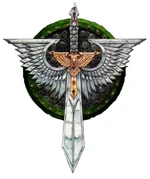
Chapter Badge of the Dark Angels
The Dark Angels make use of very different terminology when referring to the Chapter's officers as compared to that commonly used by other Space Marine Chapters. This is because the Dark Angels have continued to draw upon the ancient military traditions of The Order in organising the Chapter. In general, this terminology is also replicated in most, but not all, of the Unforgiven Successor Chapters of the Ist Legion.
See Also
Deathwatch

Chapter Iconography of the Deathwatch
Although formally counted as a Chapter, the Deathwatch has a highly unusual organisation since it serves as the Chamber Militant of the Inquisition's Ordo Xenos, which bears little resemblance to that laid down in the Codex Astartes. While a regular, "Codex Chapter" is organised so as to be highly mobile and flexible, and to be deployed almost anywhere in the galaxy on short notice, the Deathwatch often focuses on one threat, in one region. This means that a Watch Commander is able to tailor his forces to the task at hand. Some Watch Fortresses stand guard over vast Ork empires, ever ready to oppose the nigh-unstoppable invasions they periodically unleash. Others guard against more shadowy threats, far harder to detect yet every bit as dangerous. Still more face a myriad of foes and must constantly adapt to an ever-changing strategic situation. The Deathwatch has access to all of the specialised war machines used by other Chapters, and more. Even if a Watch Fortress makes no regular use of such equipment, it keeps mothballed stocks of everything from Attack Bikes to Strike Cruisers, for use as and when required.
In structure, the Deathwatch does not adhere to the strict organisation of squads and companies that the Codex Astartes dictates. The only relevant tactical unit is the Kill-team, which may be organised and equipped in any way the Watch Captains deem appropriate. In one mission the team may go to war on Space Marine Assault Bikes, and in the next mounted on a mighty Land Raider. Those Battle-Brothers with the requisite knowledge might go to war clad in hulking Terminator Armour, or in lightweight Scout Armour with Chameleonic Cloaks. Occasionally, several Kill-teams are combined into a larger force, a sure sign that a highly dangerous foe is to be faced. It is perhaps inevitable that Space Marines new to a term of service in the Deathwatch might experience a period in which they must adjust to this foreign mode of organisation. This is especially the case when it comes to Chapters that adhere rigidly to the Codex Astartes, such as the Ultramarines and their Successors. In practice, a Battle-Brother who could not adjust would not be sent to the Deathwatch, and those that do are often the most highly effective of warriors.
See Also
Space Wolves
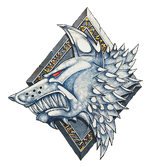
Chapter Badge of the Space Wolves
The Space Wolves strongly resist the central command structure of the Imperium. The sons of Russ never fully bowed to the Codex and certainly do not now. Theirs is a philosophical deviance. Given that they live for the honour of battle, it is almost certain that the younger Space Wolves will abandon a standard tactical structure in favour of simply rushing headlong at the enemy, howling at the tops of their voices.
See Also
White Scars
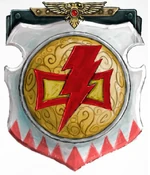
Chapter Badge of the White Scars
Following the defeat of Horus, during the tumult of the Second Founding, Jaghatai Khan was amongst those Primarchs who willingly embraced the wisdom of Guilliman's great work, the Codex Astartes. Ever since, the White Scars have adhered to the teachings of the Codex, but have always maintained the long-ingrained traditions of their own culture alongside them.
See Also
Codex Astartes Excerpts
"They shall be my finest warriors, these men who give themselves to me. Like clay, I shall mould them, and in the furnace of war forge them. They will be of iron will and steely muscle. In great armour shall I clad them and with the mightiest guns will they be armed. They will be untouched by plague or disease, no sickness will blight them. They will have tactics, strategies, and machines such that no foe can best them in battle. They are my bulwark against the Terror. They are the Defenders of Humanity. They are my Space Marines, and they shall know no fear."
- —The Emperor of Mankind
"Let them bestride the galaxy like the gods of old. Sheltering Mankind from destruction at the hands of an uncaring universe."
- — Roboute Guilliman, as laid down in the Apocrypha of Skaros. (Space Marine Codex 5th Edition)
"Consider the magnitude of your duty at leisure, but act without hesitation when action is required."
- — Roboute Guilliman, as laid down in the Codex (Space Marine Codex 3rd Edition, "Legio Astartes Daily Rites")
"The warrior who acts out of honour cannot fail. His duty is honour itself. Even his death -- if it is honourable -- is a reward and can be no failure for it has come through duty. Seek honour as you act, therefore, and you shall know no fear."
- — Roboute Guilliman, (Space Marine Codex, 4th Edition)
"They shall be pure of heart and strong of body, unsullied by doubt and untainted by self-aggrandizement. They will be bright stars in the firmament of battle. Angels of death whose swift wings bring extermination to the enemies of man. So it shall be for a thousand times a thousand years, unto the end of eternity and the extinction of mortal flesh."
- — Roboute Guilliman, (Ultramarines Codex, 2nd Edition
"As you are a knight in service of the Emperor, so is the Rhino your steed. Honour it, respect it, see that its needs are met, and it shall serve you well through all the battles you must face."
- — Roboute Guilliman, as laid down in the Apocrypha of Skaros (Space Marine Codex 5th Edition)
"Of the Tactical Space Marine, bedrock of his Chapter and paragon to his brothers, I shall tell thee. He shall be steeped in the lore of battle and schooled in all manner of weapons and strategy. With Combat Blade, Boltgun and Grenade shall he assail the foe. But these are mere tools: a Tactical Marine's true weapons are his courage, his wits and his dedication to his brothers. He will bring the foe to battle in a manner and time of his choosing, never himself caught unready or ill-prepared for the task at hand. In defence he shall be as stalwart as the mountain, a bulwark stood firm against the enemies of Man. In attack he shall strike with the wrath of the Immortal Emperor, felling the foe without mercy, remorse or fear."
- — Roboute Guilliman, as laid down in the Apocrypha of Skaros (Space Marine Codex, 5th Edition)
"And of the Assault Marine so do I decree: He shall descend upon the perfidious foe as an Angel of Judgement from on high. Let the jump pack be his wings and the roar of its engines a hymn of retribution. Let the chainsword be his sceptre of decree, its harsh voice singing joyfully with each and every blow. With it shall the Assault Marine bring bloody retribution to the heretic, the traitor and all alien transgressors who trespass on the Emperor's domains. So will the Assault Marine be the hunter of warlords and the slayer of kings. His armour shall run slick with the life blood of the vanquished, and all shall honour his name"."
- — Roboute Guilliman, as laid down in the Apocrypha of Skaros (Space Marine Codex 5th Edition)
"A Devastator's reach shall be without limit and his touch without mercy. Fire shall roar from his fingertips, but it shall consume him not. Thunder will roar when he calls, yet it will swallow him not. Let the Devastator Squad be thy blazing wrath, bringing the light of the Emperor's justice to the darkest corners of the battlefield. Wherever he stands, that shall be his fortress of righteousness. He shall hold in his gift the fate of all who pass before his unblinking gaze. All shall fear him, and he shall fear no one."
- — Roboute Guilliman, as laid down in the Apocrypha of Skaros (Space Marine Codex, 5th Edition)
"Use your Bike Squad as a blade, striking the enemy and turning aside his counter-blows in equal measure. But in all things beware that speed is nothing without direction, just as even the mightiest weapon is worthless without careful aim. A Biker's stance should always be resolute and dauntless, but never immobile or rigid. Speed is his advantage, and surprise his deadliest weapon. In fluidity he will find success and in success shall he find renown."
- — Roboute Guilliman, as laid down in the Apocrypha of Skaros (Space Marine Codex, 5th Edition)
"As a commander your tools and devices shall be myriad, yet the wise man knows that battles are won by flesh, not the machine. Flesh can learn, whilst the machine must be forever instructed. Flesh knows loyalty to its brothers and veneration of its Emperor, whilst the machine knows not these things. Whenever the day is darkest and victory in doubt, look not to the machine for aid, but to your Battle-Brothers. The machine can only bring victory if you tell it how such a thing can be done. Your brothers will walk through fire, they will stride through the most terrible carnage at a single word from your lips and they will bring you victory simply because you ask it of them."
- — Roboute Guilliman, as laid down in the Apocrypha of Skaros (Space Marine Codex, 5th Edition)
"Make the Predator's virtues your own. Let your resolve become as impervious as the Predator's armoured hull and let your rage strike with the righteous fury of its guns. As it crushes the foe beneath its remorseless advance, so shall you smite the traitor and the alien without hesitation or regret. Know that to take the field alongside a Predator is to fight at the side of one of mankind's most honoured guardians. To strive with less than your all beneath its Iron Gaze is to dishonour yourself and your Battle-Brothers before one of mankind's greatest heroes."
- — Roboute Guilliman, as laid down in the Apocrypha of Skaros (Space Marine Codex, 5th Edition)
"Know thy duty, and discharge it above all else."
- — Codex Astartes, Chapter IV, Verse 1 (Deathwatch: Rites of Battle, pg. 14)
Sources
- Codex: Blood Angels (5th Edition), pp. 7-8, 25, 27, 40, 80
- Codex: Dark Angels (6th Edition), pp. 11, 14-15, 17, 33, 35, 46
- Codex: Space Marines (6th Edition), pp. 8-15, 246
- Codex: Space Marines (5th Edition), pp. 7-9, 21-22,
- Codex: Space Marines (4th Edition), pp. 7-9
- Codex: Space Wolves (5th Edition), pp. 9, 14
- Codex: Ultramarines (2nd Edition), pp. 9-10, 12-13, 17-19, 22-23, 25, 28-30, 32-36, 39
- Deathwatch: Core Rulebook (RPG), pp. 12-15, 38, 43, 45, 52, 54, 79, 153, 174, 182-184, 312
- How to Paint Space Marines (2004), pp. 34, 36, 38, 40-42, 44-48, 93-95
- Insignium Astartes: The Uniforms & Regalia of the Space Marines by Alan Merrett, pp. 9-38, 40-49, 51
- Index Astartes I, "Codex Astartes: The Holy Tome of the Space Marines," by Rick Priestley and Andy Chambers, pp. 11-16
- Index Astartes III, "Warriors of Ultramar: The Ultramarines Space Marine Chapter," by Graham McNeill, pp. 18, 22
- Warhammer 40,000: Rulebook (6th Edition), pp. 168, 187, 225, 389, 403
- Age of Darkness (Anthology) edited by Christian Dunn, "Rules of Engagement" by Graham McNeill
- Armageddon (Novel), by Aaron Dembski-Bowden, pp. 464
- Stratagem (Audio Drama) by Nick Kyme

